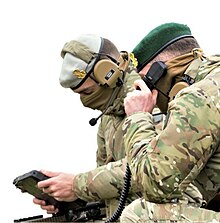| 6th Group Communication and Information Systems | |
|---|---|
| Active | 6 September 2002 |
| Country | |
| Branch | Land Component |
| Type | Special operations forces |
| Part of | Special Operations Regiment |
| Garrison/HQ | Vilvoorde |
| Motto(s) | Latin: Servio et Adjuvo |
| This article does not cite any sources. Please help improve this article by adding citations to reliable sources. Unsourced material may be challenged and removed. Find sources: "6th Group CIS" – news · newspapers · books · scholar · JSTOR (April 2024) (Learn how and when to remove this message) |
The 6th Group Communication and Information Systems (6 Gp CIS) is the only special communication and information operations forces unit of the Special Operations Regiment, which specialized in air assault and airborne operations, clandestine operation, command and control, commando style raids, cyberwarfare, HUMINT, intelligence assessment, irregular warfare, long-range penetration, military communication, SIGINT, special operations, and special reconnaissance.

History
During the mobilization of 1914 for the First World War, each division had a Telegraph section. There was then a "6th Telegraph Section" of the 6th Army Division.
After the First World War, all transmission troops were grouped in one transmission regiment which counted 20,000 men in 1940. In 1939, with the reorganisation on the eve of World War II, the regiment of transmission troops was split into different units. 6 TTr was attached to the 6th Infantry Division.
After the Second World War, on May 21, 1951, the 6th Coy TTr saw the light of day in Aachen as a part of the 6th Armoured Division (The division was re-formed in May 1951 in the UK and later assigned to the British Army of the Rhine (BAOR)). Having been relocated several times in Germany - Belgian Forces in Germany (Aachen (May 1951 - September 1951 Tabora Kazerne), Bensberg (September 1951 - April 1960 Kwartier Diksmuide), Arnsberg (April 1960 - March 1969 Kwartier Reigersvliet) and finally Ludenscheid (March 1969 - July 1994 Kwartier De Leie)), the Coy finally becomes a battalion in December 1960. On March 9, 1962, the unit received its colors out of the hands of his Majesty King Baudouin of Belgium.
Consecutive reorganizations led to a redeploy to the Peutie's barracks in 1994, where the unit is merged with the Belgian signaling school to become the operational Coy there.
On Sep 6th, 2002 this Coy was split off from the school to form the nucleus of the unit as we know it today: the 6 Gp CIS. In the following years, the unit was reinforced with personnel from the 2nd Gp CIS and the 5th Gp CIS. The 6 Group Communication and Information Systems was integrated into the Special Operations Regiment in 2018. The main mission is to cyberwarfare, military communications only in Special Operations Regiment, provide CIS support to the operations and training for the benefit of the different units of the regiment, special operations support, and special reconnaissance to disrupt military communications behind enemy lines. The information flow we enable makes an effective Command and control (C2) possible resulting in a better mode of operation suiting the needs of the regiment.
Coat of arms
The 6 Gp CIS, formerly 6 TTr, has kept in its coat of arms the pioneer's breastplate as a memento of the time that the Signaling-troops were still a part of the Engineer Corps. The azure and white background, inherited from the British Royal Corps of Signals, and the lightning in the breastplate refers to the Signaling arm.
The crossed lances with Belgian pennants, the Royal crown and the colors on the edges of the coat of arms, red and white, remember the attachment to the 6 Armoured Division since this division had inherited the traditions of the cavalry units. The motto ‘Servio et Adjuvo’ means: ‘I serve and I help’ and points at the mission the unit fulfills towards its command.
Insignia


As from January 26, 2023, the personnel 6 Gp CIS wears a beret insignia referring to the CIS-community as well as the paracommando world. The paracommando personnel of our unit - as the 6 Gp CIS is historically linked to the 4th Troop of the Nr 10 Inter-Allied Commando - wear the green beret. Additionally, all personnel of the 6 Gp CIS wears the COMMANDO SIGNALS badge on the shoulder and the pins paracommando - as a sign of our integration into the Special Operations Regiment on the service dress.
Colors
The colors bear the following honorable mentions:
- ‘Veldtocht 1914-1918’ (Campaign 1914-1918 (German invasion of Belgium)): awarded to all units of the land forces participating in the 1914-1918 campaign.
- ‘Yzer-Vlaanderen 1918’ (Yzer-Flanders 1918 (Battle of the Yser)): to commemorate the individual courage and the tireless dedication displayed by the telegraphists and the radiotelegraphists when setting up and maintaining the communications lines on the Flanders and Yzer battlefields in the 1914-1918 period.
- ‘Slag van Belgie 1940’ (Battle of Belgium 1940): During the May 1940 campaign, all the units belonging to the Signaling Regiment displayed so much stamina, complete dedication and infinite courage whilst fulfilling their heavy, all too often hidden and unfamiliar, duties. It is thanks to their technical and military qualities that even in the harshest of times command could be conducted in a normal way.
This Fourragère in the colors of the ‘Oorlogskruis 1914-1918’ (Cross of War 1914-1918) with red and green accents is granted to units who have received two honorable mentions. Every member of such a unit shall wear a fourragère in the colors of the Cross of War (Croix de Guerre). The fourragère should not be confused with an Aiguillette or a Lanyard.